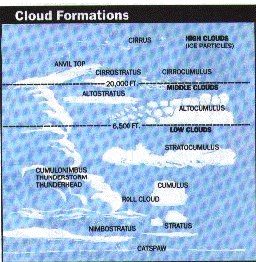Know Your Weather Signs

Checking the weather before you leave for a day of boating is important but it will not prevent weather problems. At many times of the year and in different areas of the country, the weather can change rapidly, and even professionals have trouble predicting these changes.
Weather changes generally come from the west. While underway, you should continue to check the weather. If you have a marine radio you can get weather reports on 162.55 MHz or 162.40 MHz, or from local Coast Guard radio stations. If you have a portable radio, tune to a station that gives frequent weather updates.
Flat clouds (or stratus -- little vertical development) are normally associated with stable air. Puffy clouds (or cumulus - considerable vertical development) indicate unstable air. The greater the vertical development of the cloud, the greater the instability. Thunderstorm clouds have the greatest vertical development and the associated weather is quite violent.
If you are caught in foul weather:
- Reduce speed. Proceed with caution. Put on PFD.
- Head for nearest shore that is safe to approach.
- Head bow into waves at about a 40 degree angle.
- Secure loose items. Have emergency gear ready.
- Keep bilges free of water.
- Seat passengers on bottom of boat near center line.
- If your engine fails anchor the boat.